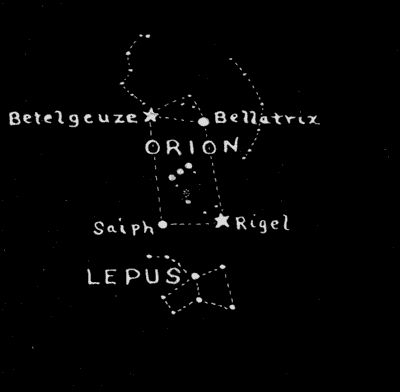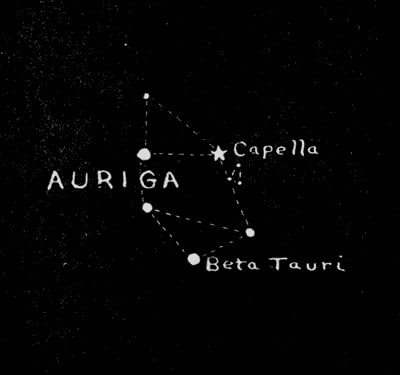III FEBRUARY
Across the meridian, due south, between eight and nine o'clock in the evening in the early part of February, lies Orion, The Warrior, generally considered to be the finest constellation in the heavens. Orion is directly overhead at the equator, and so is seen to advantage from all parts of the world except the extreme northern and southern polar regions.
A group of three faint stars outlines the head of Orion. His right shoulder is marked by the deep-red, first-magnitude star Betelgeuze (meaning armpit), and his left shoulder by the bright white star Bellatrix, The Amazon. Orion stands facing Taurus, The Bull, and brandishes in his right hand a club, outlined by a number of faint stars extending from Betelgeuze toward the northeast. The top of the club lies near the tips of the horns of Taurus. In his left hand he holds up a lion's skin, which we can trace in another curving line of faint stars to the west and northwest of Bellatrix. The brilliant, blue-white, first-magnitude star Rigel lies in the left foot, and the second-magnitude star Saiph, a little to the east of Rigel, is in the right knee. Three evenly spaced stars lying in a straight line that is exactly three degrees in length form the Belt of Orion, and from the Belt hangs the Sword of Orion, outlined by three faint stars. The central star in the Sword appears somewhat blurred and is the multiple star Theta, in the midst of the great Orion nebula, the finest object of its kind in the heavens. Entangled in the meshes of this glowing nebula are a number of brilliant suns, appearing to us as faint stars because of their great distance. The star Theta, in the heart of the nebula, is seen with a powerful telescope to consist of six stars; that is, it is a sextuple star. Even with a small telescope, four of these stars can readily be seen, arranged in the form of a small trapezium. The lowest star in the Sword is a triple star, and the entire constellation abounds in double, triple, and multiple stars.
From the central portion of the nebula extend many branches and streamers of nebulous light, and it is known that the entire constellation of Orion is enwrapped in the folds of this nebulosity, which forms a glowing, whirling mass of fiery gases in rapid rotation. This constellation is remarkable for the fact that all of its brighter stars, with the exception of the deep-red Betelgeuze, form one enormous, connected group of stars. They are all more or less associated with the great nebula and its branches, and are all extremely hot, white or bluish-white stars, known as helium stars, because the gas helium is so conspicuous in their atmospheres. The Orion stars are the hottest and brightest of all the stars.
Blazing Rigel, Bellatrix, and Saiph, marking three corners of the great quadrilateral, of which Betelgeuze marks the fourth corner, are all brilliant helium stars. So are the three stars in the Belt and the fainter stars in the Sword and the great nebula.

February—Orion
It has been estimated that the great Orion group of stars is over six hundred light-years from the earth, or about forty million times more distant than the sun. For more than six centuries the rays of light that now enter our eyes from these stars have been traveling through space with the speed of lightning. So we see Orion not as it exists today, but as it was six centuries ago. The extent of the Orion group of stars is also inconceivably great. Even the central part of the great nebula, which appears to our unaided eyes only as a somewhat fuzzy star, would extend from here to the nearest star and beyond, while our entire solar system would be the merest speck in its midst.
Betelgeuze, the red star that marks the right shoulder of Orion, is, as we have said, not a member of the Orion group. It has been estimated that it is about two hundred light-years from the earth, or only about one-third as far away as the other stars of the constellation.
Betelgeuze very recently has attracted universal attention, and will probably be considered an object of historic interest in the future, because it is the first star to have its diameter measured with the new Michelson interferometer, which is now being used so successfully to measure the diameters of the largest stars. The truly sensational discovery has been made that Betelgeuze is a supergiant of the universe, with a diameter of about 275,000,000 miles. Our own sun, which is known as a "dwarf" star, has a diameter of 864,000 miles. That is, Betelgeuze would make about thirty million suns the size of our own. If placed at the center of the solar system, it would fill all of the space within the orbit of Mars; and the planets Mercury, Venus, and the Earth would lie far beneath its surface. Measurements of the diameters of other giant stars which are now being made with the interferometer give results quite as startling as have been obtained in the case of Betelgeuze; and it has been found that several of these stars may even exceed Betelgeuze in size. Such a star is Antares, the fiery-red star in the heart of Scorpio, which is such a conspicuous object in the summer evening skies. All these huge stars are deep red in color, and some of them vary irregularly in brightness. Betelgeuze is one of the stars that changes in brightness in a peculiar manner from time to time. When shining with its greatest brilliancy it is a brighter object than the nearby star Aldebaran, in Taurus; but a few months or a year later it may lose so much of its light as to be decidedly inferior to Aldebaran. We may note for ourselves this remarkable change in the brightness of Betelgeuze by comparing the two stars from time to time.
Directly south of Orion lies the small constellation of Lepus, The Hare, which is made up of third-magnitude and fourth-magnitude stars. The four brighter stars are arranged in the form of a small, but distinct, quadrilateral, or four-sided figure, which may be easily seen in our latitudes. The small constellation of Columba, The Dove, which lies just south of Lepus, is so close to the horizon that it can not be seen to advantage in the mid-latitudes of the northern hemisphere. Neither Lepus nor Columba contain any object of unusual interest.

February—Auriga
Due north of Orion, and lying in the zenith at this time, is Auriga, The Charioteer, represented, strange to say, with Capella, a goat, in his arms. The beautiful first-magnitude star Capella, golden-yellow in color, serves us in identifying the constellation. Close at hand are The Kids, represented by a group of three faint stars. Capella is one of the most brilliant stars of the northern hemisphere. It is almost exactly equal in brightness to Arcturus and Vega, stars conspicuous in the summer months, and it is a shade brighter than magnificent blue-white Rigel in Orion. Capella is about fifty light-years distant from the earth and is fully two hundred times more brilliant than our own sun. At the distance of Capella, the sun would appear to be considerably fainter than any one of the three stars in the nearby group of The Kids.
Capella is attended by a companion star so close to its brilliant ruler that it can not be seen as a separate star save with the aid of the most powerful telescopes. Its distance from Capella has been very accurately measured, however, by means of the interferometer, which is giving us the measurements of the diameters of the giant stars. It is known that this companion sun is closer to Capella than our planet earth is to the sun.
At no time of the year shall we find near the meridian so many brilliant and beautiful stars as appear in the month of February at this time in the evening. In addition to Capella, which is one of the three most brilliant stars in the northern hemisphere of the heavens, we have, in Orion alone, two stars of the first magnitude, Betelgeuze and Rigel, and five stars of the second magnitude, Bellatrix and Saiph and the three stars in the Belt. In addition, we have not far distant in the western sky, fiery Aldebaran in Taurus, and close on the heel of Orion in the east, Sirius, the brightest star in the heavens, in the constellation of Canis Major, The Greater Dog, as well as the first-magnitude star Procyon in Canis Minor, The Lesser Dog. Of these two groups we shall have more to say under the constellations for March.





